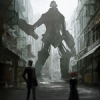quote:
Original post by dede
You do realize that all of my examples are from REAL games...
Of course. But mistakes have been made in the implementation of real games - many mistakes. And we learn from those mistakes. We learn what works, what doesn''t work, what almost works; we learn that we need extensive playtesting, because as robust as the game may seem when we play it "as intended", completely different things happen when users play it "as they want".
I can back up my assertions with real games too.
Midtown Madness 2 had an extremely robust pathfinding system for both traffic and pedestrians, by embedding a lot of traffic information in the roads, by precomputing motion splines and by aggregating pedestrian behavior. How do I know this? I read the post mortem. Any game designer or developer worth his salt, aspiring or professional, should seek out and read post mortems on a wide variety of games, because of the gains in perspective that they present.
As many bad examples as we have, we also have some shining ones where things
worked.
quote:
Even tho we can cheat, the only acceptible way to cheat, is to make the game so linear, that neither the player nor the AI have a choice, they have to do things in order.
No, I disagree. Besides, there''s nothing inherently wrong with linearity, and piecemeal linearity can be very effective for macro non-linearity (essentially creating a non-linear experience by assembling linear segments based on user actions). If you use linear
templates rather than explicit realizations, then you can effectively pseudo-script action even in unforseen circumstances.
quote:
Original post by Waverider
Perhaps if the player decides to play a second time, these missions can be skipped. I do think it would give an interesting perspective, though. The player starts out in training, and the leaders talk about how in a war, people die, etc. blah blah, and then they go through the field operations. It''s all practice, by the book, focus on the objectives, serve the armed forces, nice clean aircraft carrier decks, etc. etc.
If the player chooses to be a pilot, one field operation could just be some dogfighting Top Gun style, where pilots are talking about their successes afterwards on deck, making it all one big game. Or ground troops capturing each other, maybe even joking around while you have your gun pointed at them.
It''s a great idea, but you have to remember that the game can''t afford to drag from the player perspective, or the gamer may get bored with the title and never get to see the shock phases. Fairly rapid progress into the "meat" of the game is necessary.
It''s like watching a movie with too much build-up (*cough*
Phantom Menace, or
Attack of the Clones *cough*). I still haven''t watched either of those movies through, though I''ve seen them both several times (if I start from the beginning I fall asleep, so I tend to start half to three-quarters of the way through).
quote:
When the actual entry into the war begins and the player sees what really happens for the first time, I think it would be effective for it to be a smack in the face. Any kind of pumping up the player gets from the safety and success of training (along with the seeming invincibility of their military) should be quelled rather quickly, and refine itself into becoming a set of skills needed to complete the real objectives, while still having to deal with the human aspect of it all.
Absolutely.








